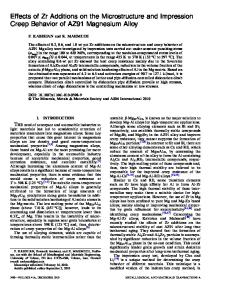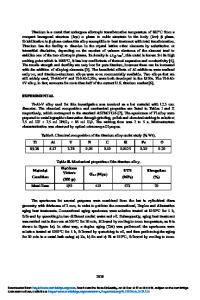Effect of Sb on the microstructure and mechanical properties of AZ91 magnesium alloy
- PDF / 2,241,420 Bytes
- 8 Pages / 612 x 792 pts (letter) Page_size
- 27 Downloads / 324 Views
INTRODUCTION
THE magnesium alloy, as the lightest structural metal, has been widely used in automobile, electronics and aerospace industries[1–4] due to its desirable combination of properties, including low density, high specific strength and specific stiffness, superb damping and electromagnetic shielding capacities, excellent machinability, and good castability.[5] However, only a small amount of R&D has been carried out on it as compared with the aluminum alloy, and its applications are also limited.[6] Principal reasons for this are its relatively poor mechanical properties at room and elevated temperature.[7] Although some Mg alloys have obtained, good creep resistance at elevated temperature by alloying with some costly elements such as Zr, Ag, Y, Th, and RE,[8] the usage of these expensive alloys are restrained to high-performance engines such as in Formula 1 race cars, air plane, and missiles.[9,10] This situation demands for intensive research to be conducted on the effects of alloying elements on the microstructure and properties of the Mg alloy.[11] Antimony is a surfaceactive element extensively used as a modifier in Al-Si alloys.[12] It was found that the addition of Sb into the Mg alloy results in grain refinement[13] and formation of compounds on grain boundaries,[14] which can improve room and elevated temperature strength,[15] creep properties,[16] and even fluidity.[11] Thus, Sb is considered as an important element to replace the RE partially or to take the place of Ag for future high strength Mg alloy development and the existing alloy modification.[11] However, it is also commonly QUDONG WANG and YANPING ZHU, Associate Professors, WENZHOU CHEN, Graduate Student, and WENJIANG DING, Professor, are with the State Key Laboratory of Metal Matrix Composites, Shanghai Jiaotong University, Shanghai 200030, People’s Republic of China. M. MABUCHI, Senior Researcher, is with National Industrial Research Institute of Nagoya, 1-1 Hirate-cho, Kita-ku, Nagoya 462-8510, Japan. Manuscript submitted December 29, 1999. METALLURGICAL AND MATERIALS TRANSACTIONS A
held that Sb can impair plasticity and ductility.[17] Pekguleryuz suggested that further investigation should be performed on the effects of Sb on the microstructure and mechanical properties of Mg alloys, especially for Mg alloys containing the Zn and Al, given the low elongation of Mg-Sb binary alloy.[11] In this study, the effects of Sb on the microstructure and mechanical properties of AZ91, the most widely used Mg alloy to date, have been investigated. II. EXPERIMENTAL The present alloys were prepared using AZ91 alloy ingots and metal Sb. Table I shows the chemical compositions of the alloys. The melting was carried out in a 20 kg resistance crucible furnace. Antimony was added at 600 ⬚C to 650 ⬚C. The melt of the magnesium alloy was refined at 720 ⬚C to 730 ⬚C and then held for 20 minutes before pouring. The cover flux was added before charging and during melting to prevent ignition. The ambient temperature tensile specimens with a diameter of 16 m
Data Loading...











